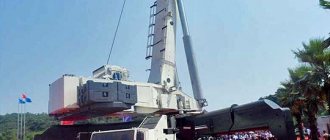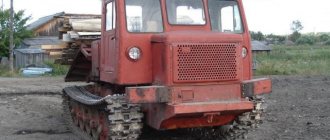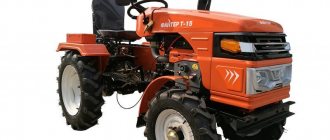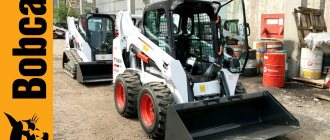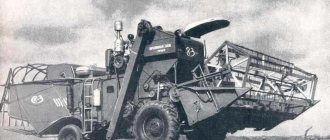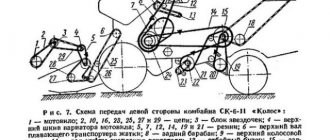Soviet combines
In pre-revolutionary times, there were no combine harvesters in Russia; harvesting was carried out using horse-drawn reapers. Russian combine harvester construction originated in the late 20s and early 30s.
The first grain harvesting combines were brought to the USSR from the USA. The first domestic model - Kommunar - appeared in the early 40s. last century at the Zaporozhye plant. In 1931, Rostselmash began operating, producing the Stalinets-1 model, and a year later similar machines appeared from Saratov. The Stalinets 6 combine was produced in 1947.
1936 - appearance of the SKAG-5A machine, capable of harvesting moistened grain; 1947 - the first self-propelled unit S-4. Since 1956, the SK-3 combine has been produced, since 1962 - SK-4, since 1969 - SKD-5 Sibiryak. The Niva car was produced by Rostselmash in 1970, and the Kolos (SK-6-II) was produced at the same time by the Taganrog plant.
Stalinist
Cars of this brand were trailed and were produced in 1931-1958. The Stalinets 6 combine is the last in the series and the first post-war machine that participated in the development of virgin lands. It had a throughput capacity of 2.5 kg/s. It uses:
- modernized thresher of the Stalinets-1 unit with increased wheel sizes;
- the header of the Kommunar combine increased to 4.9 m;
- bunker with a capacity of 1.8 m³;
- carburetor engine of the U-5MA brand with a power of 40 hp. With.;
- L-type conveyor rotary straw walker.
Other
The production of combine harvesters in the USSR and their improvement were constant. Trailed vehicles were replaced by self-propelled ones in 1947 (the first-born - S-4). Of the latest brands - released in 1970:
- Niva. Manufacturer: Rostselmash.
- Ear. Manufacturer: Taganrog Combine Harvester Plant.
At the same time as grain crops, Soviet beet harvesters were produced. Work on their creation began in 1020-1930. from the mechanization of individual operations. In 1948, the first self-propelled vehicle, LNG-1, appeared. Subsequently, the following units were produced:
- terminating type, in which the beets were first pulled out of the soil and then the tops were cut off;
- cutting off the tops, after which the process of extracting root crops from the ground took place.
Also in the Soviet Union, corn harvesting, potato harvesting, hemp harvesting and silage harvesting machines were produced:
- “Khersonets-7” is a corn harvester, which was produced by the Kherson plant from the 60s to the 90s. The trailed unit was used in tandem with the MTZ-80, D-74 tractors for harvesting ripe corn, clearing the leaves from the cobs and then chopping them.
- KKU-2A "Druzhba" (KKU-2A) is an elevator potato harvester, produced on a combine harvester since the 1960s. Working width – 1.4 m, hopper volume – 700 kg. The unit harvests root crops from two rows at a distance of 70 cm from each other at a speed of up to 4 km/h.
- KSG-3.2 (in the city of Birobidzhan) is a self-propelled silage harvesting machine. It has the following technical characteristics: engine power (SMD-18K) – 100 hp, working width – 3.2 m and cutting height of forage crops – 100 mm, bunker volume – 9 m3.
Story
Founded in October 1941 on the basis of evacuated factories: them. Ukhtomsky (from Lyubertsy, Moscow region) and “Kommunar” (from Zaporozhye). Already in December 1941, production of products for the front - shells and mines - began at the production facilities of the Krasnoyarsk Distillery. The first trailed grain harvesters of the Krasnoyarsk plant (Kommunar) were produced on May 1, 1944. In 1945–47, the plant was the first in the country to produce self-propelled combines, the models of which were constantly improved. The 2-drum grain harvesting machines of the “Sibiryak” type have become especially famous. “Siberians” were used everywhere in the USSR on all types of soils for harvesting grain and rice. Compared to previous ones, this machine had 30% higher productivity and provided a 3-fold reduction in losses. In 1970, for the development of the Sibiryak combine, the enterprise was awarded the Gold Medal of the USSR Exhibition of Economic Achievements. At the international fair in Budapest, “Sibiryak” received a bronze medal, and its rice harvesting modification received a silver medal.
In the 1970s The Krasnoyarsk Combine Harvester Plant, with a workforce of over 12 thousand people, was the largest enterprise in the city. In addition to the main products (harvesters), a wide range of consumer goods was produced: from washing machines to meat grinders. In 1974, a regional production association for the production of grain harvesting equipment was formed on the basis of the enterprise. In addition to the combine plant located in Krasnoyarsk, it included the Nazarovo Agricultural Engineering Plant (Nazarovo), Krasnoyarsk Design and Design and Technological Institute of Combine Harvester Engineering. In November 1974, the 100,000th grain harvester rolled off the plant's assembly line, and in May 1983, the 500,000th. In the second half of the 1980s. The plant began production of the new Yenisei-1200 combine harvester. The equipment of Krasnoyarsk combine harvester builders successfully worked in various agro-climatic zones, on fields of varying yields.
In the 1990s. The company's personnel were reduced by more than 60%, production volume decreased in 1998 to 260 machines. In the same year, the investment and financial group Sibmashholding acquired a controlling stake, and the recovery from the crisis began. Simultaneously with the increase in production, the company’s specialists began testing a new generation combine harvester (4th class) “Yenisei-950” (“Ruslan”), which is characterized by increased productivity. After updating the factory equipment, mass production of Ruslans began. According to the results of the first half of 2003, KZK managed to overtake its main competitor (Rostselmash) in terms of production volume (1,867 vehicles in 6 months); assembly of combines from Krasnoyarsk spare parts was also carried out at the Oryol Combine Plant (also part of Agromashholding, which became the owner of KZK in 2003). The success of machine builders was facilitated by the expansion of state lending for purchases of agricultural machinery, which began in 2001 through Rosagroleasing OJSC. However, in the face of declining effective demand, already in 2005 the plant found itself in crisis. There was a sharp reduction in production until a temporary stoppage of work at the beginning of 2006. The prospects for overcoming the crisis are associated with the interest of the regional authorities, as well as with the arrival of a new owner - the Tractor Plants concern, which acquired Agromashholding in May 2006.
Lit.: From “Kommunar” to “Sibiryak”. Krasnoyarsk Order of the Red Banner of Labor combine harvester plant (1941-1981). Krasnoyarsk, 1982; Krasnoyarsk region. Krasnoyarsk, 1984; Krasnoyarsk Essays on the history of the city. Krasnoyarsk, 1988.
A. K. Kirillov, A. I. Timoshenko
Russian combines
Russian-made grain harvesters are represented by several brands:
- Rostselmash, which occupies 70% of the market throughout the Russian Federation, offering a full range of machines for grain harvesting;
- Agromash holding, which continued the traditions of Siberian combine harvesters;
- Terrion company, which implements the concept of the Finnish Sampo combine harvester in Russia;
- The youngest of the combine harvester manufacturers is the Muromets company.
Rostselmash
This is a group of companies including 13 enterprises.
It produces products under the ROSTSELMASH and VERSATILE brands in 4 countries at 10 production sites.
Its units are supplied to 56 countries. Success explained:
- 85-year history associated with the production of combine harvesters;
- a large range of manufactured models;
- optimal ratio of the quality of units and their price;
- presence of a large number of service stations.
The range of grain harvesters includes machines:
- NOVA. Belongs to 3rd class. It is unpretentious and repairable. Has a 180 hp engine. pp., works with headers 3-6 m wide. Has a grain capacity of 4.5 m³.
- Vector series. Model 410 is the same Don 1500, but with a modern body. 450 - tracked - the company's only model with such a propulsion system. Cars with an engine power of 255 hp. With. equipped with 5-9 meter wide headers, they collect grain into a hopper with a capacity of 6 m³.
- The Acros series (grades 5-6), represented by a large number of modifications designed for harvesting grain from different areas. The most popular models are 585/550 and 595. The latter is for large fields with average yield.
- The Torum series (7th class), the new models of which (780/750, 785/770) are among the most productive (40 t/h) rotary machines in the world, are capable of effectively harvesting crops from weedy and wet fields. They have a comfortable cabin, bunkers with a capacity of 10.5 and 12 m³, with Mercedes engines (425, 506 hp). Work is underway to create an unmanned model Torum 760.
- RSM 161. It is versatile and allows you to harvest grains, legumes, cereals, and oilseeds from 2000 hectares of fields per season. The car has a new cabin that provides panoramic visibility.
Agromash
The manufacturer of combine harvesters has been on the domestic market for a long time, but due to a poorly developed dealer network, it cannot boast of great success. It produces several models that are capable of harvesting grains, soybeans, cereal crops, sunflowers, and legumes: Agromash 3000, 4000, 5000, 5121.
Cars of 3-5 classes. Equipped with:
- engines with a power of 180-280 hp. With.;
- headers 4-8 m wide;
- grain storage bins - 5-8 m³.
Terrion
The localization of production of combine harvesters of this brand in Russia is insignificant, although it is constantly expanding. Terrion machines today are Finnish Sampo combines, assembled from large components at a domestic enterprise.
The line of models is small - 3 series, 1 of which is a mini grain harvester for breeding plots. Rest:
- Series 2000. Includes machines of class 2-3, capable of removing work with a width of 3.1-5.1 m. Units with engine power of 100-185 hp. s., grain bins with a capacity of 3.3-5.5 m³.
- Series 3000, the models of which belong to the 4th class. They have more powerful (210-300 hp) power units and can be equipped with headers 5.1-7.5 m wide. Grain storage bins with a volume of 5.2-7.6 m³.
Muromets
There is only one combine harvester with this name - Muromets 1500. The model is from an enterprise that entered the market in 2014. The firstborn, belonging to the 4th class, has an affordable price, which is explained by:
- high localization;
- simplicity of design.
The machine cannot be classified as an ultra-modern combine harvester. But the cost and low maintenance of the model are attractive to farms with limited profits. It is easy to prepare an operator to operate it; repairs are not difficult due to the availability of spare parts on the market.
Muromets has 1500:
- powerful (240 hp) power unit;
- ability to work with 2 headers with a 6/7 m grip;
- grain bin holding 6.3 m³ of grain.
Activity
Currently, a self-propelled grain harvester of class 4 “Yenisei KZS 950” and its modifications are being produced. Yenisei combines are also assembled by the Oryol Combine Harvester Plant from components produced at the Krasnoyarsk Combine Harvester Plant.
Over the entire existence of the plant, more than 700 thousand combines have been produced. Combine harvesters were supplied to the domestic market and for export (to Bulgaria, China, Vietnam, Iraq, Mexico and other countries).
Repressed Germans from the Volga region, the so-called Labor Army soldiers, took part in the construction of the plant.
Brands of produced combines
- 1944 - “Communar”
- 1947 - “S-4”
- 1959 - “SK-3”
- 1965 - “SK-4”
- 1969 - “SKD-5”
- 1981 - “SKD-6”
- 1985 - “Yenisei-1200”
- 1994 - “Yenisei-1200NM”
- 2000 - “Yenisei-1200U” (“Ruslan”)
- 2003 - “Yenisei-950” (“Ruslan”)
The main problem was a shortage of castings. This production was created literally in the open air. First they installed the forms, then they built the walls and laid the roof. Even the tool shop had to be located in a small room, which was also poorly equipped and poorly lit. This, however, did not prevent us from launching the production of cutting and measuring tools in the shortest possible time.
In addition to spare parts for agricultural machinery, the plant produced mortars and ammunition
Under these conditions, local management made absolutely fantastic plans for the plant. Already in 1942, a resolution of the executive committee of the regional Council of Deputies and the bureau of the regional committee of the Kommunar party ordered the restoration of the production of grain harvesters. They were supposed to make 1,500 of them per year, including 500 in the first half of 1942.
Despite the fact that the plant director assumed such obligations, the company was unable to fulfill them. Moreover, military orders grew. In 1943, the plant was supposed to master the production of special 82 mm chemical OT mines with liquid filler. Then demands were made to organize the production of mines with adapter sleeves and ignition cups. A great achievement of the first years of the war was that the plant simultaneously continued to produce spare parts for agricultural machinery. In 1943, 7 times more of them were produced than in 1942. The plant implemented its plans for defense products by more than 100 percent.
All this happened against the backdrop of a shortage of trained workers. In 1943, more than 800 truants and deserters left the plant.
In 1944, the production structure of plant No. 703 underwent dramatic changes - the production of 45 mm shells, as well as fragmentation mines, ceased, but the production of OT-type mines doubled.
In addition, as the construction of the first stage of the combine plant was completed, the company received plans for their production - 550 grain harvesting machines, as well as 50 threshers, were supposed to come off the assembly line. The conversion has begun. The imminent end of the war dictated new conditions. In 1944, the production of defense products at the 703rd began to decline. In May 1945 it was completely stopped. Kommunar was able to return to its main profile - the production of equipment for the country's agriculture.

